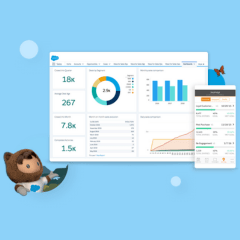Transforming Business Efficiency
Process Re-engineering
- Flexible solution
- Setup in seconds
Connect with us
One Of The Most Experienced
Salesforce Partner

Projects Completed
Salesforce Certifications
Years Experience
Enhanced Efficiency and Productivity: Process re-engineering helps identify and eliminate bottlenecks and redundancies, resulting in more streamlined and efficient workflows. This leads to faster turnaround times and improved productivity.
Cost Savings: By optimizing processes, organizations can reduce operational costs and achieve better resource allocation. The elimination of unnecessary steps and automation of routine tasks contribute to significant cost savings.
Improved Quality and Customer Satisfaction: Re-engineering processes can lead to higher quality outputs and better service delivery. Enhanced processes ensure that customer needs are met more effectively, improving overall satisfaction.
Greater Flexibility and Agility: Redesigned processes are often more adaptable to changes in the business environment. This flexibility allows organizations to respond quickly to market demands and emerging opportunities.
Leading Salesforce Partner in Dubai, UAE Since 2010
Transform your business with Aphidas, with over 320+ successful projects, we bring unrivaled expertise & legacy of excellence to help your organization thrive.
- 320+ Clients
- 50 + Certificates
- 10 * Rating

The Process
The Process Re-engineering Workflow
Leading Salesforce Partner in Dubai
Phases of Process Re-engineering
The typical phases include:
01
Assessment
Evaluating existing processes to identify areas for improvement.
02
Design
Developing new process designs based on assessment findings.
03
Implementation
Executing the new process designs and integrating them into daily operations.
04
Monitoring
Continuously reviewing and optimizing processes to ensure they meet performance goals.
Leading Salesforce Partner in Dubai, UAE Since 2010
Why Choose Aphidas?


With years of experience in Salesforce implementation, consultation, customization, and integration, we bring unparalleled expertise to your business. Our team of certified professionals understands the nuances of various industries and can tailor solutions to meet your specific needs.
Our case studies demonstrate the tangible benefits and success stories of our clients, showcasing our ability to deliver exceptional results. We have a track record of transforming businesses and enhancing their operational efficiency.
We prioritize understanding your unique needs and challenges, providing tailored solutions that drive growth and efficiency. Our goal is to build long-term partnerships and ensure our clients’ success.
From initial consultation to ongoing support, we offer a full spectrum of services to ensure your Salesforce journey is smooth and successful. Whether it’s implementation, customization, or training, we’ve got you covered.
6 benefits
Key Elements and Benefits the Approach
Start today
Ready to get started?
Take the next step
Gain insights from Salesforce experts on implementing and optimizing Salesforce CRM. Get practical tips and advice on maximizing the value of your Salesforce investment.
Question And Answers
General FAQs About
Process Re-engineering
Salesforce Process Re Engineering is the redesign of existing business workflows within Salesforce to eliminate inefficiencies and align operations with best practices. It involves analyzing current CRM usage, identifying bottlenecks, and rebuilding processes using automation, data, and modern Salesforce tools to improve productivity and customer experience.
The re-engineering process refers to the systematic analysis and redesign of business workflows to improve outcomes. When applied to Salesforce, it focuses on optimizing how users interact with the platform by automating tasks, restructuring data flows, and enhancing user experience for improved performance and efficiency.
The 7 steps of business process reengineering are: set objectives, map existing processes, identify inefficiencies, redesign workflows, implement changes in Salesforce, test new processes, and train users. These steps help organizations transform legacy operations into efficient, CRM-driven workflows using Salesforce Process Re Engineering.
The main goal of process re-engineering is to dramatically improve business efficiency by rethinking outdated workflows. With Salesforce, this means replacing manual tasks with automation, simplifying complex processes, and enabling faster decision-making through real-time data access and streamlined CRM operations.
The process re-engineering strategy within Salesforce involves analyzing business needs, redesigning workflows to reduce redundancies, leveraging automation, and aligning CRM usage with growth goals. It emphasizes user adoption, scalability, and measurable outcomes to ensure long-term process improvement and digital transformation.
Businesses need Salesforce Process Re Engineering to stay competitive, reduce operational costs, and enhance customer service. Legacy processes often create delays and errors. Re-engineering with Salesforce modernizes workflows, improves team collaboration, and boosts the return on CRM investments through better automation and reporting.
Common signs include slow system performance, high manual workload, duplicate data entry, low CRM adoption, and outdated workflows. If your Salesforce setup feels inefficient or disconnected from business goals, it's time to consider process re-engineering to realign operations and boost performance.
Salesforce automation tools like Flow, Process Builder, and Apex support process re-engineering by reducing manual steps, enabling instant updates, and triggering actions across departments. These tools help businesses design smarter, faster workflows that save time and improve service delivery across the CRM.
Data plays a central role by revealing performance gaps, process delays, and user behavior. During re-engineering, data is used to benchmark current performance, guide redesign efforts, and monitor post-implementation success. Clean, actionable data ensures that redesigned workflows deliver measurable improvements.
Challenges include resistance to change, lack of internal expertise, integration complexity, and unclear goals. These can be managed by involving stakeholders early, setting clear KPIs, working with experienced Salesforce consultants, and testing processes thoroughly before full rollout to ensure success.







